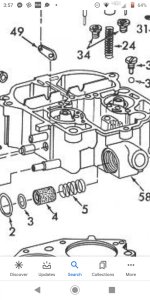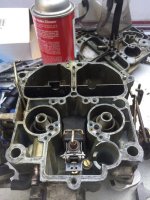I have a problem that I cannot solve and the workshop manual did not help me either.
1981 Crusader 270 engine. I just bought this boat and on the port side engine I had a carburetor problem (Rochester Quadrojet). I decided to replace it with a remanufactured one for $ 349 (exactly the same, but with a small difference, read on). I installed it, I also have a new gasket under the carburetor, new gaskets under the intake manifold. But when I connect the vent pipe from the fuel pump to the carburetor, the engine runs for 10-15 seconds and stops.
My old carb didn’t have a fitting for this tube and the clear tube just lay on the intake manifold. Now the new carburetor has this fitting, but with the tube connected, the engine cannot work for a long time. In general the engine runs fine at all RPMs but only for 10-15 seconds, then it just stops. The ventilation pipe is clean, no fuel inside. The fitting on the carburetor (as far as I understand) goes straight to the intake manifold because when the engine stops and the tube is disconnected from the carburetor there is a little exhaust smoke coming out of this fitting. Also, this tube has a strong vacuum when the engine is running.
If the tube is disconnected - the engine continues to work perfectly at all RPMs, yesterday we checked this and were at sea for 1 hour. All perfectly.
I have a suspicion that the fuel pump needs to be replaced but I'm not sure about that. I decided to ask you. I would be grateful for your help.
1981 Crusader 270 engine. I just bought this boat and on the port side engine I had a carburetor problem (Rochester Quadrojet). I decided to replace it with a remanufactured one for $ 349 (exactly the same, but with a small difference, read on). I installed it, I also have a new gasket under the carburetor, new gaskets under the intake manifold. But when I connect the vent pipe from the fuel pump to the carburetor, the engine runs for 10-15 seconds and stops.
My old carb didn’t have a fitting for this tube and the clear tube just lay on the intake manifold. Now the new carburetor has this fitting, but with the tube connected, the engine cannot work for a long time. In general the engine runs fine at all RPMs but only for 10-15 seconds, then it just stops. The ventilation pipe is clean, no fuel inside. The fitting on the carburetor (as far as I understand) goes straight to the intake manifold because when the engine stops and the tube is disconnected from the carburetor there is a little exhaust smoke coming out of this fitting. Also, this tube has a strong vacuum when the engine is running.
If the tube is disconnected - the engine continues to work perfectly at all RPMs, yesterday we checked this and were at sea for 1 hour. All perfectly.
I have a suspicion that the fuel pump needs to be replaced but I'm not sure about that. I decided to ask you. I would be grateful for your help.




